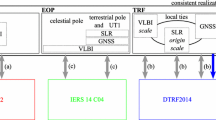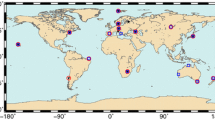Abstract
Precise transformation between the celestial reference frames (CRF) and terrestrial reference frames (TRF) is needed for many purposes in Earth and space sciences. According to the Global Geodetic Observing System (GGOS) recommendations, the accuracy of positions and stability of reference frames should reach 1 mm and 0.1 mm year\(^{-1}\), and thus, the Earth Orientation Parameters (EOP) should be estimated with similar accuracy. Different realizations of TRFs, based on the combination of solutions from four different space geodetic techniques, and CRFs, based on a single technique only (VLBI, Very Long Baseline Interferometry), might cause a slow degradation of the consistency among EOP, CRFs, and TRFs (e.g., because of differences in geometry, orientation and scale) and a misalignment of the current conventional EOP series, IERS 08 C04. We empirically assess the consistency among the conventional reference frames and EOP by analyzing the record of VLBI sessions since 1990 with varied settings to reflect the impact of changing frames or other processing strategies on the EOP estimates. Our tests show that the EOP estimates are insensitive to CRF changes, but sensitive to TRF variations and unmodeled geophysical signals at the GGOS level. The differences between the conventional IERS 08 C04 and other EOP series computed with distinct TRF settings exhibit biases and even non-negligible trends in the cases where no differential rotations should appear, e.g., a drift of about 20 \(\upmu \)as year\(^{-1 }\)in \(y_{\mathrm{pol }}\) when the VLBI-only frame VTRF2008 is used. Likewise, different strategies on station position modeling originate scatters larger than 150 \(\upmu \)as in the terrestrial pole coordinates.





Similar content being viewed by others
References
Altamimi Z, Sillard P, Boucher C (2002) ITRF2000: A new release of the International Terrestrial Reference Frame for earth science applications. J Geophys Res 107:ETG 2–1 ETG 2–19. doi:10.1029/2001JB000561
Altamimi Z, Collilieux X, Legrand J, Garayt B, Boucher C (2007) ITRF2005: A new release of the International Terrestrial Reference Frame based on time series of station positions and Earth Orientation Parameters. J Geophys Res 112(B09):401. doi:10.1029/2007JB004949
Altamimi Z, Collilieux X, Metivier L (2011) ITRF2008: an improved solution of the International Terrestrial Reference Frame. J Geod 85:457–473. doi:10.1007/s00190-011-0444-4
Altamimi Z, Dermanis A (2012) The choice of reference system in ITRF formulation. In: Sneeuw N et al (eds) VII Hotine-Marussi Symposium on Mathematical Geodesy, International Association of Geodesy, Symposia 137. Springer, Berlin, pp 329–334
Altamimi Z, Rebischung P, Métivier L, Collilieux X (2016) ITRF2014: a new release of the International Terrestrial Reference Frame modeling nonlinear station motions. J Geophys Res Solid Earth 121. doi:10.1002/2016JB013098
Belda S, Ferrándiz JM, Heinkelmann R, Nilsson T, Schuh H (2016) Testing a New Free Core Nutation empirical model. J Geodyn. doi:10.1016/j.jog.2016.02.002
Bizouard C, Gambis D (2011) The combined solution C04 for Earth Orientation Parameters consistent with International Terrestrial Reference Frame 2008. Technical Note. http://hpiers.obspm.fr/iers/eop/eopc04/C04.guide.pdf
Bloßfeld M, Seitz M, Angermann D (2014) Non-linear station motions in epoch and multi-year reference frames. J Geod 88:45–63. doi:10.1007/s00190-013-0668-6
Böckmann S, Artz T, Nothnagel A (2010) VLBI terrestrial reference frame contributions to ITRF2008. J Geod 84:201–219. doi:10.1007/s00190-009-0357-7
Böhm J, Werl B, Schuh H (2006) Troposphere mapping functions for GPS and very long baseline interferometry from European Centre for Medium-Range Weather Forecasts operational analysis data. J Geophy Res 111:B2. doi:10.1029/2005JB003629
Böhm J, Böhm S, Pany A, Plank L, Spicakova H, Teke T, Schuh H (2012) The New Vienna VLBI Software VieVS. Geod for Planet Earth. Proc 2009 IAG Symp:1007–1011. doi:10.1007/978-3-642-20338-1126
Chao B, Hsieh Y (2015) The earths free core nutation: Formulation of dynamics and estimation of eigenperiod from the very-long-baseline interferometry data. Earth Planet Sci Lett 36:483–492
Dehant V (2002) Report of the IAU working group on ‘Non-rigid Earth Nutation Theory’. Highlights Astron 12:117–119
Dick W (2013) IERS Annual Report 2011. International Earth Rotation and Reference Systems Service, Central Bureau. Frankfurt am Main: Verlag des Bundesamts für Kartographie und Geodäsie, p 159. ISBN:978-3-86482-046-5
Ding XL, Zheng DW, Dong DN, Ma C, Chen YQ, Wang GL (2005) Seasonal and secular positional variations at eight collocated GPS and VLBI stations. J Geod 79:71–81. doi:10.1007/s00190-005-0444-3
Eriksson D, MacMillan DS (2014) Continental hydrology loading observed by VLBI measurements. J Geod 88:675–690. doi:10.1007/s00190-014-0713-0
Ferrándiz JM, Gross R (2014) The New IAU/IAG Joint Working Group on Theory of Earth Rotation. Proc IAG Symp 143 (to appear)
Ferrándiz JM, Belda S, Heinkelmann R, Getino J, Schuh H (2016) Reference frames in earth rotation theories (to be submitted)
Feissel M, Bourquard D, Charlot P, Eisop E, Essaifi N, Lestrade JF, Arias EF, Boucher C, Altamimi Z (1993) Earth Orientation and Related Reference Frames. In: Smith DE, Turcotte DL (eds) Contributions of space geodesy to geodynamics: earth dynamics. American Geophysical Union, Washington, D.C. doi:10.1029/GD024p0099
Fey AL, Ma C, Arias EF, Charlot P, Feissel-Vernier M, Gontier AM, Jacobs CS, Li J, Macmillan DS (2004) The Second Extension of the International Celestial Reference Frame: ICRF-EXT.1. Astron J 127:3587–3608. doi:10.1086/420998
Fey AL, Gordon D, Jacobs CS, Ma C, Gaume RA, Arias EF, Bianco G, Boboltz DA, Boeckmann S, Bolotin S, Charlot P, Collioud A, Engelhardt G, Gipson J, Gontier AM, Heinkelmann R, Kurdubov S, Lambert S, Lytvyn S, MacMillan DS, Malkin Z, Nothnagel A, Ojha R, Skurikhina E, Sokolova J, Souchay J, Sovers OJ, Tesmer V, Titov O, Wang G, Zharov V (2015) The Second Realization of the International Celestial Reference Frame by very long baseline interferometry. Astron J 150:58. doi:10.1088/0004-6256/150/2/58
Heinkelmann R, Nilsson T, Karbon M, Liu L, Lu C, Mora Diaz JA, Parselia E, Raposo-Pulido V, Soja B, Xu M, Schuh H (2014a) The GFZ VLBI solution: characteristics and first results. In: Behrend D, Baver K, Armstrong K (eds) Proc 8th IVS general meeting “VGOS: the new VLBI network”, Shanghai, China 2014, pp 330–334
Heinkelmann R, Belda S, Ferrándiz JM, Schuh H (2014b) The consistency of the current conventional celestial and terrestrial reference frames and the conventional EOP series. In: Malkin Z, Capitaine N (eds) Proc Journ 2014: “Systèmes de référence spatio-temporels” Pulkovo observatory, pp 224–225
Heinkelmann R, Belda S, Ferrándiz JM, Schuh H (2015) How Consistent are The Current Conventional Celestial and Terrestrial Reference Frames and The Conventional Earth Orientation Parameters? In: Rizos C, Willis P (eds) Proceedings of the IAG Commision 1 Symposium 2014: Reference Frames for Applications in Geosciencies (International Association of Geodesy Symposia). Springer, Berlin. doi:10.1007/1345_2015_149
Hilton J, Capitaine N, Chapront J, Ferrándiz JM, Fienga A, Fukushima T, Getino J, Mathews P, Simon JL, Soffel M, Vondrak J, Wallace P, Williams J (2006) Report of the International Astronomical Union Division I Working Group on Precession and the Ecliptic. Celest Mech Dyn Astron 94:351–367. doi:10.1007/s10569-006-0001-2
Krásná H, Böhm J, Schuh J (2013) Free Core Nutation observed by VLBI. Astron Astrophys 555:A29. doi:10.1051/0004-6361/201321585
Krásná H, Böhm J, Plank L, Nilsson T, Schuh H (2014) Atmospheric effects on VLBI-derived terrestrial and celestial reference frames. In: Rizos C, Willis P (eds) Earth in the edge: science for a sustainable planet. IAG Symp, vol 139. Springer, Berlin, pp 203–207. doi:10.1007/978-3-642-37222-3__26
Krásná H, Malkin Z, Böhm J (2015) Non-Linear VLBI station motions and their impact on the celestial reference frame and Earth orientation parameters. J Geod 89. doi:10.1007/s00190-015-0830-4
Lambert S (2007) Empirical Model of the Earth’s Free Core Nutation. Technical note. http://syrte.obspm.fr/~lambert/fcn/
Ma C, Arias EF, Eubanks T, Fey A, Gontier AM, Jacobs C, Archinal OSB, Charlot P (1998) The International Celestial Reference Frame as Realized by Very Long Baseline Interferometry. Astron J 116:516. doi:10.1086/300408
Ma C et al (2009) The Second Realization of the International Celestial Reference Frame by Very Long Baseline Interferometry. In: Fey AL, Gordon D, Jacobs CS (eds) IERS Technical Note, No. 35. Verlag des Bundesamts für Kartographie und Geodäsie, Frankfurt am Main, pp 1–204
Malkin Z (2010) Comparison of CPO and FCN empirical models. In: Capitaine N (ed) Proc Journ 2010: New challenges for reference systems and numerical standards in astronomy, Paris, France, pp 172–175
Malkin Z (2013a) Impact of seasonal station motion on VLBI UT1 intensives results. J Geod 87:505–514. doi:10.1007/s00190-013-0624-5
Malkin Z (2013) Free core nutation and geomagnetic jerks. J. Geodyn 72:53–58. doi:10.1016/j.jog.2013.06.001
Nilsson T, Heinkelmann R, Karbon M, Raposo-Pulido V, Soja B, Schuh H (2014) Earth orientation parameters estimated from VLBI during the CONT11 campaign. J Geod 88:491–502. doi:10.1007/s00190-014-0700-5
Petit G, Luzum B (2010) IERS Technical Note 36, vol 179. Verlag des Bundesamts für Kartographie und Geodäsie, Frankfurt am Main, p 179. ISBN:3-89888-989-6
Plag H, Pearlman M (2009) Global Geodetic Observing System: Meeting the Requirements of a Global Society on a Changing Planet in 2020. Springer, New York, p 332. doi:10.1007/978-3-642-02687-4
Seitz M, Angermann D, Blo\(\beta \)feld M, Drewes H, Gerstl M (2012) The 2008 DGFI realization of the ITRS: DTRF2008. J Geod 86:1097–1123. doi:10.1007/s00190-012-0567-2
Tesmer V, Steigenberger P, Rothacher M, Boehm J, Meisel B (2009) Annual deformation signals from homogeneously reprocessed VLBI and GPS height time series. J Geod 83:973–988. doi:10.1007/s00190-009-0316-3
Acknowledgments
SB and JMF work has been partly supported by Spanish grants CGL2010-12153-E, AYA2010-22039-C02-01, AYA2010-22039-C02-02 and APOSTD/2026/079.
Author information
Authors and Affiliations
Corresponding author
Rights and permissions
About this article
Cite this article
Belda, S., Heinkelmann, R., Ferrándiz, J.M. et al. On the consistency of the current conventional EOP series and the celestial and terrestrial reference frames. J Geod 91, 135–149 (2017). https://doi.org/10.1007/s00190-016-0944-3
Received:
Accepted:
Published:
Issue Date:
DOI: https://doi.org/10.1007/s00190-016-0944-3




